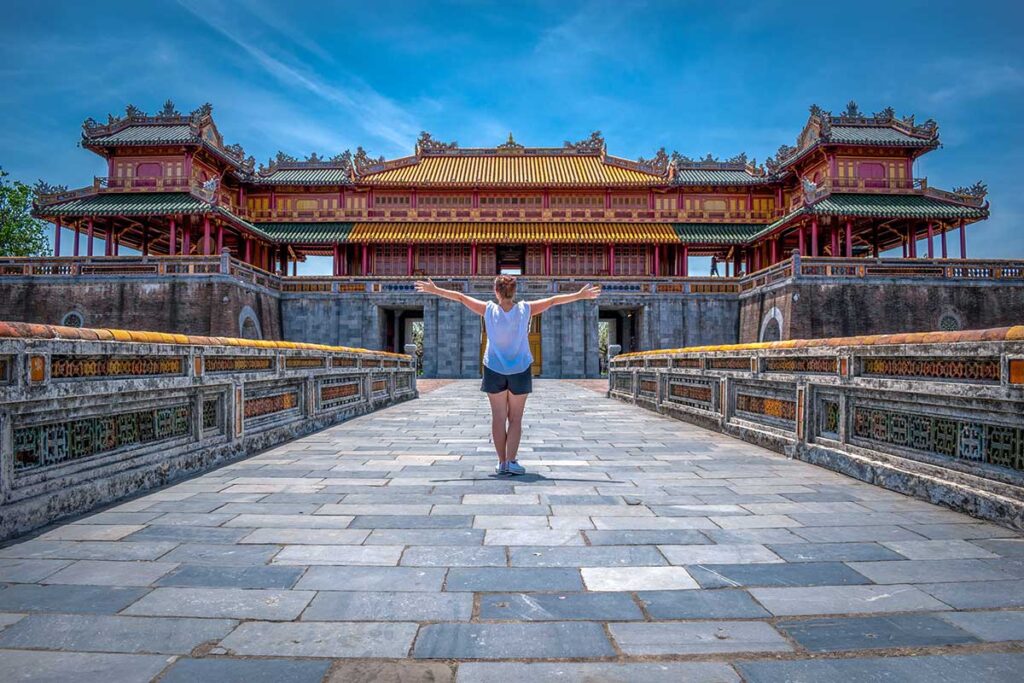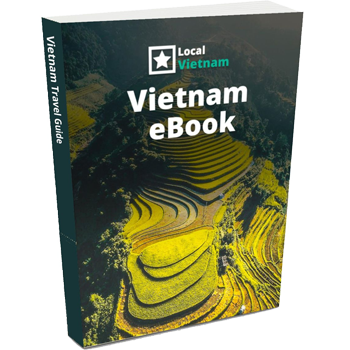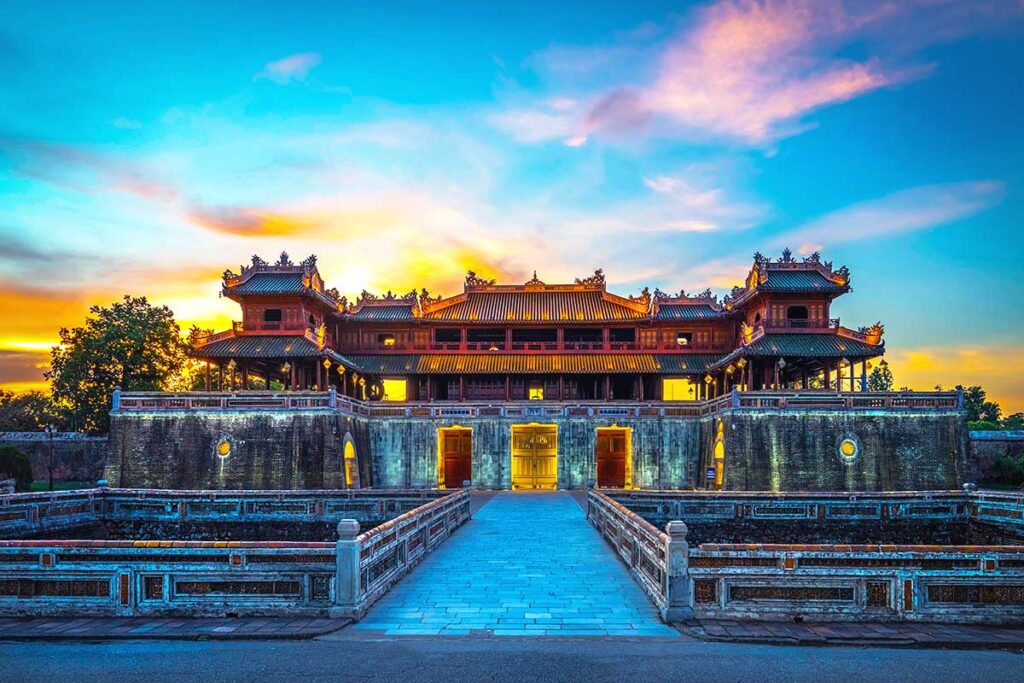What is Ngo Mon Gate?
Ngo Mon Gate is the grand southern entrance to the Hue Imperial City, the former political and ceremonial capital of Vietnam under the Nguyen Dynasty. Built in 1833, it marked the official threshold to the royal complex — a vast walled city of palaces, temples, courtyards, and the emperor’s private residence. If you’re visiting Hue today, this is the first and most iconic structure you’ll see when approaching the Imperial City.
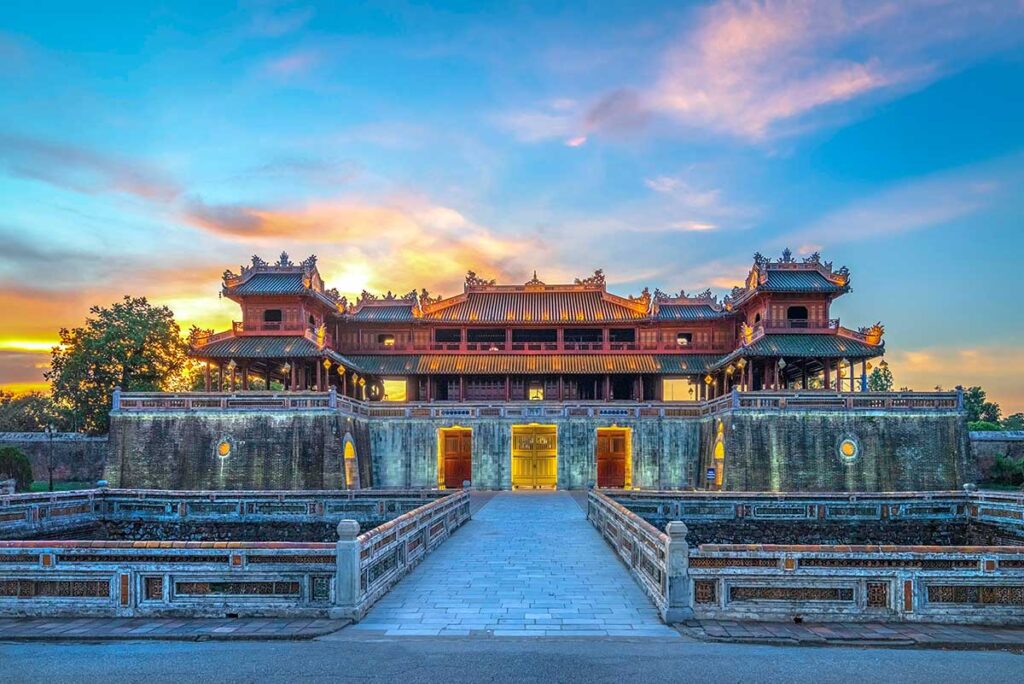
The name Ngo Mon can be translated as the “Meridian Gate.” In Sino-Vietnamese, Ngo refers to the south direction — considered the most prestigious under Confucian principles, as emperors traditionally sat facing south to rule. This direction was seen as the point of order, light, and power. While sometimes mistaken for “Noon Gate” due to the same character (Ngọ) meaning “midday,” in this case, the meaning is purely spatial, not time-based.
History of Ngo Mon Gate
Early structures before Ngo Mon
Before the Ngo Mon Gate was built, this part of the Hue Imperial City housed a simpler set of royal structures. Under Emperor Gia Long, the first Nguyen ruler, there stood the Nam Khuyet Dai, a raised platform for viewing ceremonies, along with the Can Nguyen Palace. These early buildings served basic ceremonial purposes but lacked the grand scale and symbolic design later desired by the court.
When Emperor Minh Mang began his ambitious reorganization of the imperial capital, he ordered these earlier structures dismantled to make way for a more formal and monumental gateway. This marked the start of a broader plan to elevate Hue’s imperial architecture to reflect the dynasty’s growing authority and ceremonial complexity.
Construction of Ngo Mon Gate
Ngo Mon Gate was constructed in 1833, during Minh Mang’s reign, as part of a larger effort to reinforce the Nguyen Dynasty’s power through architecture. It served as the main southern gate of the Imperial City and was aligned along the central axis that extended through the Thai Hoa Palace and into the Forbidden Purple City.
This new structure wasn’t just an upgrade — it was a statement. By placing such a monumental gate at the southern entrance, Minh Mang followed Confucian and geomantic principles, emphasizing order, hierarchy, and imperial authority. The gate immediately became a focal point of royal architecture and ritual.
Ceremonial use and symbolism
Ngo Mon Gate played a central role in the court’s public life. The emperor would appear on the upper pavilion — the Lầu Ngũ Phụng (Pavilion of Five Phoenixes) — to review military formations, receive foreign envoys, and oversee major rituals.
Some of the formal ceremonies held at the gate included:
- Truyền Lô – the official announcement of newly appointed scholars and mandarins
- Ban Sóc – the ritual of distributing the royal calendar
- Military parades and troop reviews
The layout of the gate itself enforced a strict social order:
- The central archway was reserved exclusively for the emperor.
- The two side gates were designated for civil and military mandarins, each according to rank.
- The outermost gates were used by guards, attendants, and lower officials.
This hierarchy in physical access reflected the broader structure of Nguyen society, with the emperor literally and symbolically placed at the center of power.
Turning point in history
Ngo Mon Gate also witnessed a defining moment in Vietnam’s modern history. On August 30, 1945, Emperor Bao Dai, the last ruler of the Nguyen Dynasty, stood at this very gate to formally abdicate the throne. He handed over the imperial seal and sword to representatives of the revolutionary government, ending centuries of Vietnamese monarchy.
From that moment, Ngo Mon became more than a symbol of dynastic rule — it became a monument to political change. Standing beneath its arches today, you’re not only walking through a royal gateway but through the very site where imperial Vietnam gave way to a new republic.
Architecture and layout
Overall structure
Ngo Mon Gate is a U-shaped structure built from thick brick and stone, forming a fortified base with an elevated ceremonial platform on top. It sits directly along the central axis of the Hue Imperial City, leading straight to the Thai Hoa Palace — the emperor’s main audience hall.
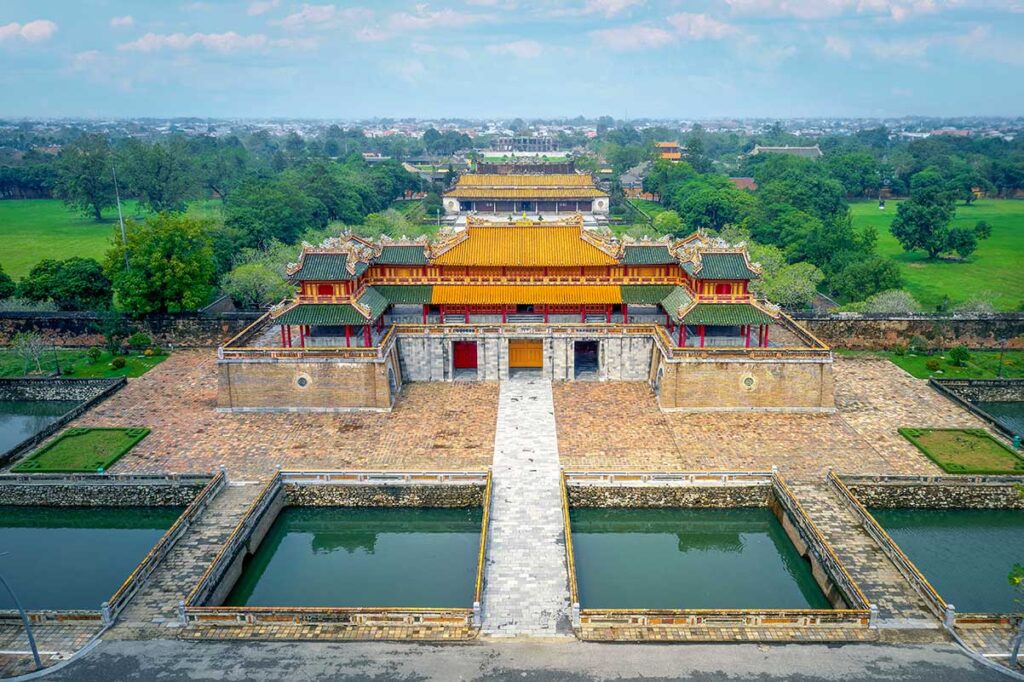
The ground level features five arched entrances, each with a specific function. The central gate was used only by the emperor, while the flanking gates served civil and military mandarins. The two outermost gates were used by lower officials, guards, and servants. This layout physically enforced the strict social hierarchy of the Nguyen court.
The Pavilion of Five Phoenixes (Lầu Ngũ Phụng)

Above the gate sits the Lầu Ngũ Phụng, or Pavilion of Five Phoenixes — a beautifully crafted wooden structure that served as a viewing platform for the emperor. Built entirely from ironwood, it features an intricate roof system covered with yellow glazed tiles (reserved for royalty) in the center and green tiles on either side.
The pavilion includes 13 rooms and a complex five-roof design that gives the impression of five phoenixes in flight — a powerful symbol of imperial grace and vigilance. It was here that the emperor stood during official ceremonies to address his court or review troops assembled below.
From the upper level, you get a commanding view over the Great Ceremony Courtyard, the Trung Dao Bridge, and the Thai Hoa Palace beyond — a layout designed to showcase royal power and ceremonial order.
Vietnamese vs Chinese Influence
Ngo Mon Gate was inspired by the Meridian Gate of Beijing’s Forbidden City, but it was adapted to reflect Vietnamese architectural traditions and local craftsmanship. While the layout and symbolism follow Confucian norms, many of the details are distinctively Vietnamese.

The use of ironwood, lacquered columns, and dragon carvings reflects local styles. The scale is smaller and more harmonious with the surrounding landscape compared to its Chinese counterpart. Where Beijing’s gate feels imposing, Ngo Mon has a balance of authority and elegance — rooted in Vietnamese identity and adapted to Hue’s imperial setting.
Restoration and preservation
War damage
Ngo Mon Gate suffered significant damage during the 1968 Tet Offensive, one of the most intense urban battles of the Vietnam War. As fighting erupted inside the Hue Citadel, the gate — positioned at the heart of the Imperial City — was hit by heavy artillery and shelling. The roof structure and upper pavilion were partially destroyed, and much of the surrounding area was left in ruins.
The attack marked a turning point in the Vietnam War and left lasting scars on many of Hue’s historic monuments, including Ngo Mon.
Restoration efforts
In the early 1970s, restoration work began to stabilize and rebuild Ngo Mon Gate. Efforts focused on reconstructing the damaged Pavilion of Five Phoenixes, using traditional materials and techniques where possible. The work was carried out under the guidance of local experts and eventually expanded to include other parts of the Hue Monuments Complex.
Today, the gate is maintained by the Hue Monuments Conservation Center, which oversees ongoing preservation projects throughout the former imperial capital. Ngo Mon’s careful restoration played a key role in helping Hue gain recognition as a UNESCO World Heritage Site in 1993. It now stands not just as a symbol of royal history, but also of Vietnam’s commitment to preserving its cultural heritage.
Visiting Ngo Mon Gate today
What to expect
Ngo Mon Gate remains the main entrance into Hue Imperial City and is the first thing you’ll see as you approach the complex. Towering and symmetrical, it immediately sets the tone for what lies beyond — a world of imperial architecture, court rituals, and dynastic power. You’ll walk through one of the side archways, just as mandarins and guards once did.
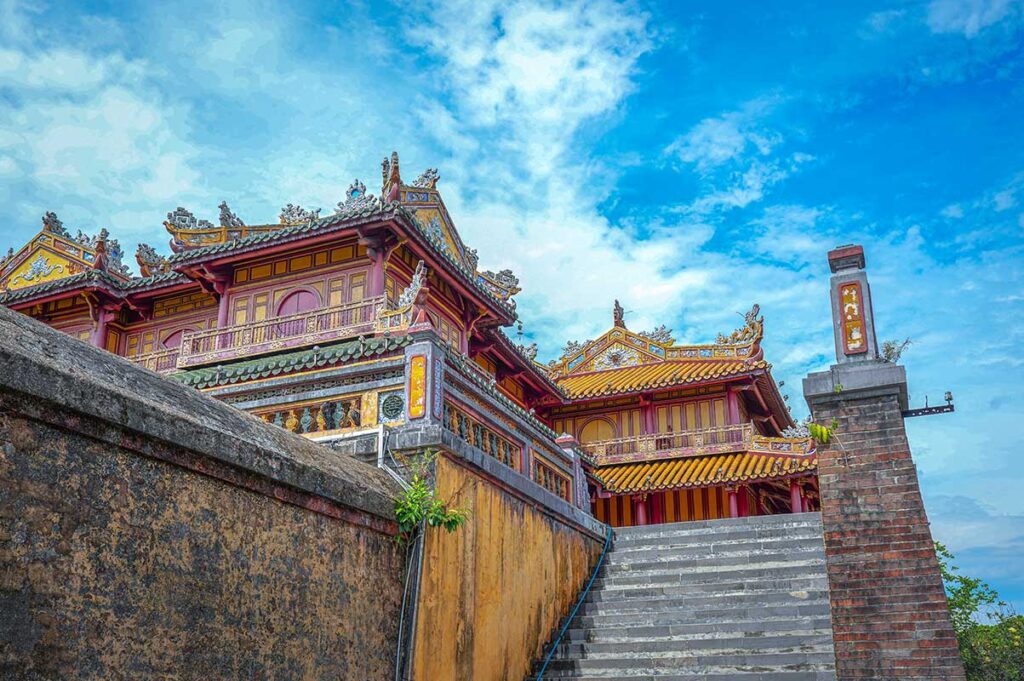

It’s often possible to go upstairs to the Pavilion of Five Phoenixes, where you can admire the wooden structure up close and look out across the central axis of the Imperial City. Whether open or not, the lower level alone is enough to appreciate the gate’s scale, detail, and historic weight.
Photography & viewpoints
Ngo Mon is easily one of the most photographed landmarks in Hue. The best spot to capture it is from the square in front of the Flag Tower, especially in the morning or late afternoon when the light hits the yellow tiles and stonework just right.
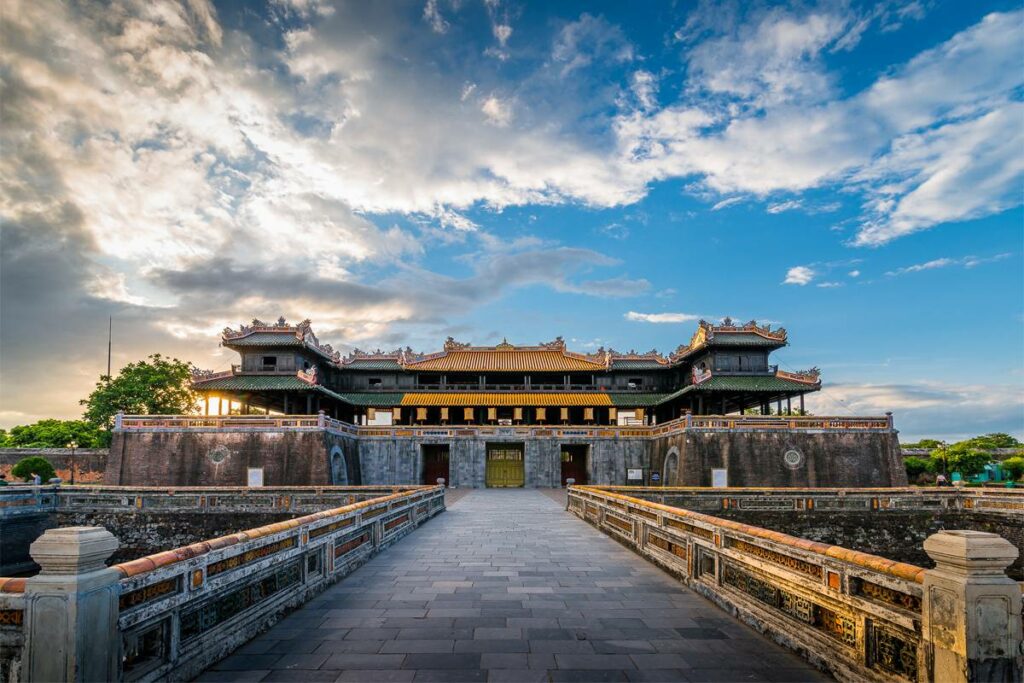
Inside the gate, stand near the start of the Trung Dao Bridge for a perfectly framed shot of the pavilion behind you and the Thai Hoa Palace directly ahead. The symmetry and ceremonial layout create a striking image from almost any angle.
Practical info
There’s no separate ticket for Ngo Mon Gate — it’s part of the general Hue Imperial City entrance, which gives access to the entire complex. Once inside, you’re free to explore the area around the gate, but access to the upper level may be restricted depending on maintenance or events.
Opening hours follow those of the Imperial City:
- Summer: 8:00 AM – 5:30 PM
- Winter: 7:30 AM – 5:00 PM
As with the rest of the citadel, dress modestly and respect signage around restricted areas or photography rules.
Hue Historical City Tour
- Includes Hue Imperial City, royal tombs, temples, and a dragon boat ride on Perfume River.
- Options Small group or private tour with hotel pickup
Beyond the gate: Hue Imperial City
Stepping through Ngo Mon Gate takes you into the heart of the Hue Imperial City — once the political and ceremonial capital of the Nguyen Dynasty. Enclosed within its massive walls are throne halls, temples, pavilions, courtyards, and the remains of the Forbidden Purple City, which was once the emperor’s private residence.
From the gate, your path follows a central ceremonial axis that leads to some of Hue’s most important imperial landmarks. These include the Thai Hoa Palace, where emperors held official audiences; the To Mieu Temple Complex, dedicated to past Nguyen rulers; and the inner walls of the Forbidden Purple City, a once-hidden royal zone now partially restored. It’s a space where symbolism, power, and history all come together — and where the scale of imperial Vietnam is on full display.
More imperial sights in Hue
Ngo Mon Gate and the Imperial City are just the beginning. Hue is home to many more impressive historical sites from the Nguyen Dynasty that are well worth exploring:
- Tu Duc Tomb – A peaceful, poetic complex built as the personal retreat of a scholarly emperor.
- Minh Mang Tomb – Known for its strict symmetry and tranquil setting, reflecting Confucian ideals.
- Khai Dinh Tomb – A bold mix of Vietnamese tradition and European design, with a richly decorated interior.
- Thien Mu Pagoda – Hue’s most iconic pagoda, overlooking the Perfume River and tied to centuries of spiritual life.
For a full overview, see our article: 10 Best Temples, Pagodas & Tombs in Hue
